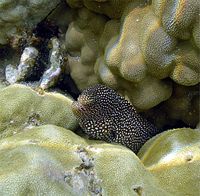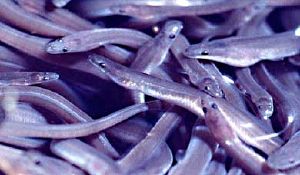Eel
| True eels | ||||||||||
|---|---|---|---|---|---|---|---|---|---|---|
 American eel, Anguilla rostrata
| ||||||||||
| Scientific classification | ||||||||||
| ||||||||||
|
See text for suborders and families. |
Eel is the common name for any of the various members of the fish order Anguilliformes, which are characterized by an elongated, snake-like body, the absence of pelvic fins, and typically without scales or with the scales embedded in the skin. Eels generally are found in marine environments or, as in the case of the freshwater eels (family Anguillidae), catadromous, spawning in marine environments and with the young eels traveling back into freshwater.
The common name eel also is applied to members of various species in the freshwater family Electrophoridae (electric eels) of the order Gymnotiformes; the marine family Cyematidae (bobtail snipe eels) in the order Saccopharyngiformes; and in the largely freshwater order Synbranchifromes (including the swamp eels in family Synbranchidae and the spiny eels in family Mastacembelidae). However, the "true eels" are placed in order Anguilliformes, which is also known as Apodes.
Eels provide various values for the ecosystem and for humans. The unique adaptations that allow eels to be successful in their environmentsâprimarily for wedging through small openings, while some are adapted to burrowing into soft substrates or living a pelagic existence (Nelson 1994)âalso adds to the wonder of nature for humans. Furthermore, many species, particularly freshwater varieties, are also popular as a food fish, particularly in Asia and Europe, where the meat is considered a delicacy (Herbst 2001). Ecologically, eels are important in food chains, acting as predators of fish and such invertebrates as crustaceans and mollusks, and being consumed in its various stages by fish, mammals, birds, and various invertebrates.
Description
Eels, members of Anguilliformes, lack pelvic fins and the associated skeletal structures. The pectoral fins (in those species that have them) are at least midlateral in position or higher and lack the posttemporal bone, which connects the shoulder girdle to the skull. The dorsal and anal fins are long, usually connecting with the tail (caudal) fin. The caudal fin lacks rays or may be absent. The body is very elongated.
The number of rays of the gill webbing ranges from six to 51, though sometimes they are absent altogether. The scales are usually absent, but if present are cycloid and embedded in the skin.
The flat and transparent larva of the eel is called a leptocephalus. A young eel is called an elver. Morphologically, the leptocephali larva of anguilliforms often differ considerably from the adults, to the extent that it is difficult to determine which leptocephali are the young of which adult (Nelson 1994). Most are less than 20 centimeters before they undergo metamorphosis to an adult, although some exceed 50 centimeters (Nelson 1994).
Depending on their species, eels can range in length from ten centimeters to three meters, and weigh up to 65 kilograms or more. The European conger, Conger conger, is the largest of the eel family, reaching three meters in length, and perhaps weighing up to 110 kilograms.
Most eels prefer to dwell in shallow waters or hide at the bottom layer of the ocean, sometimes in holes. These holes are called eel pits. Only the Anguillidae family comes to fresh water to dwell (not to breed). Some eels dwell in deep water (in case of family Synaphobranchidae, this comes to a depth of 4,000Â m), or are active swimmers (the family Nemichthyidaeâto the depth of 500Â m).
The life cycle of the eel was a mystery for a very long time, because larval eels look very different from adult eels, and were thought to be a separate species.
Classification
Nelson (1994) recognizes three suborders, 15 families, 141 genera, and about 738 species in Anguilliformes. The following classification by FishBase recognizes 15 families but in 4 suborders. Among differences are the recognition by Nelson of suborders Anguilloidei (with three families), Muraenoidei (with three families), and Congroidei (with 9 families), while FishBase recognizes suborders Anguilloidei (with six families), Congroidei (with six families), Nemichthyoidei (with two families), and Synaphobranchoidei (with one family). In Nelson (1994), suborders Anguilloidei and Muraenoidei include the same families that FishBase includes in Anguilloidei. Additional families that are included in other classifications (notably ITIS and Systema Naturae 2000) are noted below the family with which they are synomized in the FishBase system.
Suborders and Families
Suborder Anguilloidei
- Anguillidae (freshwater eels)
- Chlopsidae (false morays)
- Heterenchelyidae
- Moringuidae (spaghetti eels)
- Muraenidae (moray eels)
- Myrocongridae
Suborder Congroidei
- Colocongridae
- Congridae (congers)
- Including Macrocephenchelyidae
- Derichthyidae (longneck eels)
- Including Nessorhamphidae
- Muraenesocidae (conger pikes)
- Nettastomatidae (witch eels)
- Ophichthidae (snake eels)
Suborder Nemichthyoidei
- Nemichthyidae (snipe eels)
- Serrivomeridae (sawtooth eels)
Suborder Synaphobranchoidei
- Synaphobranchidae (cutthroat eels)
- Including Dysommidae, Nettodaridae, and Simenchelyidae
In some classifications the family Cyematidae of bobtail snipe eels is included in the Anguilliformes, but in the FishBase system and in Nelson (1994) that family is included in the order Saccopharyngiformes. The so-called "electric eel" of South America is not a true eel, but is more closely related to the carp.
Eels and Humans
Freshwater eels are a food fish, particularly popular in Asia and Europe, where their sweet, rich, firm meat is considered a delicacy (Herbst 2001). Japanese cuisine commonly uses both freshwater eels (unagi) and marine eels (conger eel, anago). Unadon is a very popular but rather expensive food. Eels are used in Cantonese and Shanghai cuisine too. The European eel and other freshwater eels are eaten in Europe, the United States, and other places around the world. A traditional East London food is jellied eels. New Zealand longfin eel is a traditional food for Maori in New Zealand. In Italian cuisine, eels from the Comacchio area (a swampy zone along the Adriatic coast) are specially praised along with the freshwater ones of the Bolsena Lake. In northern Germany, smoked eel is praised as a delicatesse.
Eels also are popular among marine aquarists in the United States, particularly the moray eel, which is commonly kept in tropical saltwater aquariums.
Elvers were once eaten by fishermen as a cheap dish, but environmental changes have lead to increased rarity of the fish. They are now considered a delicacy and are priced at up to ÂŁ700 per kg in the UK.
Eel blood is toxic, however, the toxic protein it contains is destroyed by cooking. The toxin derived from eel blood serum was used by Charles Robert Richet in his Nobel winning research that discovered anaphylaxis (by injecting it into dogs and observing the effect).
There are many historical legends surrounding eels. For instance, some Philippine tribes consider eels to be the souls of the dead. In parts of Europe there is a legend that rubbing the skin with oil of eel will cause a person to see fairies (Herbst 2002). The Egyptians were said to worship eels.
ReferencesISBN links support NWE through referral fees
- Froese, R., and D. Pauly (eds.). 2006. Anguilliformes. FishBase. Retrieved September 29, 2007.
- Herbst, S. T. 2001. The New Food Lover's Companion: Comprehensive Definitions of Nearly 6,000 Food, Drink, and Culinary Terms. Barron's Cooking Guide. Hauppauge, NY: Barron's Educational Series. ISBN 0764112589.
- Nelson, J. S. 1994. Fishes of the World, 3rd ed. New York: John Wiley & Sons. ISBN 0471547131.
Credits
New World Encyclopedia writers and editors rewrote and completed the Wikipedia article in accordance with New World Encyclopedia standards. This article abides by terms of the Creative Commons CC-by-sa 3.0 License (CC-by-sa), which may be used and disseminated with proper attribution. Credit is due under the terms of this license that can reference both the New World Encyclopedia contributors and the selfless volunteer contributors of the Wikimedia Foundation. To cite this article click here for a list of acceptable citing formats.The history of earlier contributions by wikipedians is accessible to researchers here:
The history of this article since it was imported to New World Encyclopedia:
Note: Some restrictions may apply to use of individual images which are separately licensed.

